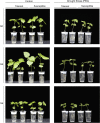Differential seedling growth and tolerance indices reflect drought tolerance in cotton
- PMID: 35820810
- PMCID: PMC9277823
- DOI: 10.1186/s12870-022-03724-4
Differential seedling growth and tolerance indices reflect drought tolerance in cotton
Abstract
Background: Cotton production is adversely effected by drought stress. It is exposed to drought stress at various critical growth stages grown under a water scarcity environment. Roots are the sensors of plants; they detect osmotic stress under drought stress and play an important role in plant drought tolerance mechanisms. The seedling stage is very sensitive to drought stress, and it needed to explore the methods and plant characteristics that contribute to drought tolerance in cotton.
Results: Initially, seedlings of 18 genotypes from three Gossypium species: G. hirsutum, G. barbadense, and G. arboreum, were evaluated for various seedling traits under control (NS) and drought stress (DS). Afterward, six genotypes, including two of each species, one tolerant and one susceptible, were identified based on the cumulative drought sensitivity response index (CDSRI). Finally, growth rates (GR) were examined for shoot and root growth parameters under control and DS in experimental hydroponic conditions. A significant variation of drought stress responses was observed across tested genotypes and species. CDSRI allowed here to identify the drought-sensitive and drought-resistant cultivar of each investigated species. Association among root and shoots growth traits disclosed influential effects of enduring the growth under DS. The traits including root length, volume, and root number were the best indicators with significantly higher differential responses in the tolerant genotypes. These root growth traits, coupled with the accumulation of photosynthates and proline, were also the key indicators of the resistance to drought stress.
Conclusion: Tolerant genotypes have advanced growth rates and the capacity to cop with drought stress by encouraging characteristics, including root differential growth traits coupled with physiological traits such as chlorophyll and proline contents. Tolerant and elite genotypes of G. hirsutum were more tolerant of drought stress than obsolete genotypes of G. barbadense and G. arboreum. Identified genotypes have a strong genetic basis of drought tolerance, which can be used in cotton breeding programs.
Keywords: Cotton; Drought stress response indices; Drought tolerance; Gossypium spp; Root growth; Seedling growth rate; Shoot growth.
© 2022. The Author(s).
Conflict of interest statement
The authors declare no conflict of interest.
Figures



Similar articles
-
Screening cotton genotypes for their drought tolerance ability based on the expression level of dehydration-responsive element-binding protein and proline biosynthesis-related genes and morpho-physio-biochemical responses.Protoplasma. 2024 Jul;261(4):783-798. doi: 10.1007/s00709-024-01935-0. Epub 2024 Feb 20. Protoplasma. 2024. PMID: 38376598
-
Exploitation of various physio-morphological and biochemical traits for the identification of drought tolerant genotypes in cotton.BMC Plant Biol. 2023 Oct 23;23(1):508. doi: 10.1186/s12870-023-04441-2. BMC Plant Biol. 2023. PMID: 37872477 Free PMC article.
-
Integrating genetic assortment and molecular insights for climate-resilient breeding to unravel drought tolerance in cotton.J Biotechnol. 2024 Nov 10;394:92-102. doi: 10.1016/j.jbiotec.2024.08.013. Epub 2024 Aug 23. J Biotechnol. 2024. PMID: 39181209
-
Genomic Dynamics and Functional Insights under Salt Stress in Gossypium hirsutum L.Genes (Basel). 2023 May 18;14(5):1103. doi: 10.3390/genes14051103. Genes (Basel). 2023. PMID: 37239463 Free PMC article. Review.
-
Adaptive strategies to drought stress in grasses of the poaceae family under climate change: Physiological, genetic and molecular perspectives: A review.Plant Physiol Biochem. 2024 Aug;213:108814. doi: 10.1016/j.plaphy.2024.108814. Epub 2024 Jun 10. Plant Physiol Biochem. 2024. PMID: 38875780 Review.
Cited by
-
Genome-wide association studies revealed partial genetic links between early vigour and precocity in macadamia.Hortic Res. 2025 Jul 4;12(9):uhaf162. doi: 10.1093/hr/uhaf162. eCollection 2025 Sep. Hortic Res. 2025. PMID: 40861039 Free PMC article.
-
Ploidy's Role in Daylily Plant Resilience to Drought Stress Challenges.Biology (Basel). 2024 Apr 24;13(5):289. doi: 10.3390/biology13050289. Biology (Basel). 2024. PMID: 38785771 Free PMC article.
-
Comprehensive Morphological and Molecular Insights into Drought Tolerance Variation at Germination Stage in Brassica napus Accessions.Plants (Basel). 2024 Nov 23;13(23):3296. doi: 10.3390/plants13233296. Plants (Basel). 2024. PMID: 39683089 Free PMC article.
-
Response of Watermelon to Drought Stress and Its Drought-Resistance Evaluation.Plants (Basel). 2025 Apr 24;14(9):1289. doi: 10.3390/plants14091289. Plants (Basel). 2025. PMID: 40364318 Free PMC article.
-
Biochemical and morpho-physiological insights revealed low moisture stress adaptation mechanisms in cotton (Gossypium hirsutum L.).Sci Rep. 2024 Oct 29;14(1):25942. doi: 10.1038/s41598-024-77204-0. Sci Rep. 2024. PMID: 39472516 Free PMC article.
References
-
- Abdelraheem A, Esmaeili N, O’Connell M, Zhang J. Progress and perspective on drought and salt stress tolerance in cotton. Ind Crops Prod. 2019;130:118–129. doi: 10.1016/j.indcrop.2018.12.070. - DOI
-
- Iqbal M, Khan MA, Chattha WS, Abdullah K, Majeed A. Comparative evaluation of Gossypium arboreum L. and Gossypium hirsutum L. genotypes for drought tolerance. Plant Genet Resour Characterisation Util. 2019;17:506–13. doi: 10.1017/S1479262119000340. - DOI
-
- Pettigrew WT. Moisture deficit effects on cotton lint yield, yield components, and boll distribution. Agron J. 2004;96:377–383. doi: 10.2134/agronj2004.0377. - DOI
MeSH terms
Substances
Grants and funding
LinkOut - more resources
Full Text Sources
Miscellaneous

